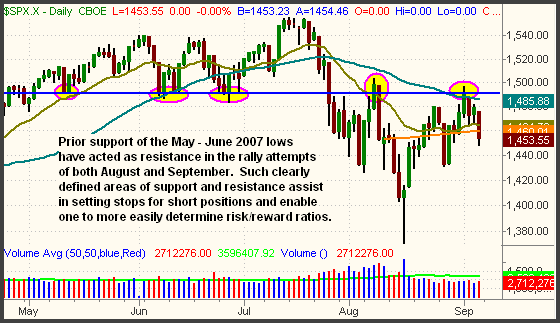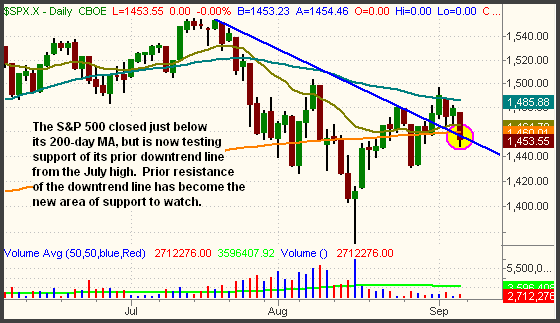| The Wagner Daily ETF Report for September 10 |
| By Deron Wagner |
Published
09/10/2007
|
Futures
|
Unrated
|
|
|
|
The Wagner Daily ETF Report for September 10
After getting off to an encouraging start last Tuesday, stocks capped the week on a negative note. Each of the major indices gapped down on Friday's open, dropped further in the morning, then chopped around in range throughout the rest of the day. By the closing bell, the S&P 500 had shed 1.7%, while both the Nasdaq Composite and Dow Jones Industrial Average similarly plunged 1.9%. The small-cap Russell 2000 and S&P Midcap 400 indices fell 2.2% and 1.8% respectively. A bit of buying in the final minutes of trading lifted the broad market off its lows, but all of the main stock market indexes still finished in the bottom third of their intraday ranges.
The worst part of Friday's action was that the losses again coincided with higher turnover. Total volume in the NYSE rose 14% above the previous day's level, as volume in the Nasdaq ticked 3% higher. The losses on higher volume caused both the S&P and Nasdaq to register a bearish "distribution day" for the second time in a week. Ugly market internals in both exchanges confirmed the selling pressure. Since peaking on September 4, the broad market has had two days of losses and one session of gains. Both of the "down" days were marked by higher volume, while volume eased during the singular "up" day. Such a price to volume pattern is negative, and is the opposite of how a healthy market should act.
Despite the broad market's weakness at the end of the week, a few industries continue to look pretty good on the long side. Both the spot gold commodity (GLD) and gold mining stocks (GDX) had massive rallies last week. We continue to look for an entry point in GLD on a pullback. This ideally would be a pullback to the hourly uptrend line or support of its prior high, around the 68 to 68.50 area. As always, subscribers will receive an e-mail alert if/when we make an intraday decision to buy GLD. In addition to gold, both the oil service and biotech sectors are showing relative strength. The Oil Service HOLDR (OIH) has entered a period of short-term price consolidation, as have several of the biotech ETFs. We're not in any of the oil ETFs, but we remain long the iShares Nasdaq Biotech Fund (IBB).
Counter-trend retracements in the broad market, such as the rally off the August 16 lows, are often short-lived. But from a technical level, the good thing is they provide clearly-defined upper and lower channels of support and resistance for use in setting stops and/or entering new positions. With the S&P 500, for example, the previous area of price support from May - June 2007 has acted as resistance in both August and September. Below, the horizontal line on the daily chart of the S&P 500 illustrates this:

Notice how rally attempts in both early August and September failed after running into resistance of the prior lows from May and June. This is because the most basic tenet of technical analysis states that prior areas of support always become the new areas of resistance after the support has been broken. Conversely, prior resistance usually acts as new support after the resistance is broken. Last Friday's close caused the S&P 500 to break below support of its 200-day MA, but finish near support of its prior downtrend line from the July high. Again, take a look at the same daily chart of the S&P 500, but with different annotations:

Circled in pink is support of the prior downtrend line that the S&P broke out above on August 31. Though the index actually closed below that trendline, it did not drop far enough below to confirm the break of support. Nevertheless, if the S&P closes below last Friday's low in today's session, it could lead to the return of substantial downward momentum. The Dow Industrials is now well below support of its prior downtrend line, but the Nasdaq Composite remains firmly above it.
Significant price divergence between the major indices continues to result in choppy, indecisive trading from day-to-day. With the S&P 500 testing support of its prior downtrend line and 200-day MA, we expect more erratic volatility in the coming week. Consider staying positioned on both sides of the market, long sectors with relative strength and short those with relative weakness. Aside from sitting in cash, this is perhaps the best way to maintain minimal risk in the current environment.
Open ETF positions:
Long - IBB, LQD, DXD, SDS
Short - (none, but DXD and SDS are inversely correlated positions)
Deron Wagner is the Founder and Head Trader of both Morpheus Capital LP, a U.S. hedge fund, and Morpheus Trading Group, a trader education firm launched in 2001 that provides daily technical analysis of the leading ETFs and stocks. For a free trial to the full version of The Wagner Daily or to learn about Wagner's other services, visit MorpheusTrading.com or send an e-mail to deron@morpheustrading.com.
|